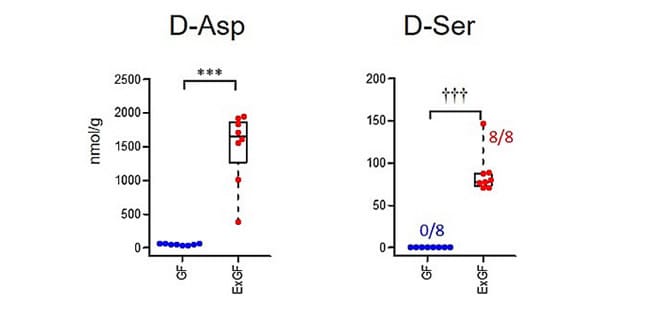January 17, 2019 | News & Notices D-amino acids produced by intestinal microbiota newly discovered with mass spectrometer — New development in D-amino acid research achieved with high-sensitivity, high throughput chiral amino acid analysis —
A group comprising Mitsuharu Matsumoto, a senior researcher at Kyodo Milk Industry Co.,Ltd., Shimadzu Corporation, and Junko Iida, a visiting professor at Osaka University Shimadzu Analytical Innovation Research Laboratory (and senior manager of Life Sciences Business Department, Analytical & Measuring Instruments Division, Shimadzu Corporation) used the “method of simultaneous analysis of chiral amino acids using high-sensitivity LC-MS/MS”* developed in collaboration between Shimadzu Corporation and Eiichiro Fukusaki, a professor at Graduate School of Engineering, Osaka University, to develop an analytical method capable of highly sensitive analysis of chiral amino acids produced by intestinal microbiota. Measurements were performed using a Shimadzu high-sensitivity liquid chromatograph mass spectrometer (LC-MS/MS). This analytical method detected 12 free D-amino acids produced by intestinal microbiota, of which 9 D-amino acids were confirmed for the first time to be present in a free state in the intestinal lumen. D-amino acids have recently garnered attention for their physiological activity in the body. The analytical method will help to further functional research of the intestinal microbiota through D-amino acids. Results were published in Scientific Reports, a British Journal, on December 17, 2018.
| * | Fukusaki Laboratory at Graduate School of Engineering, Osaka University, developed a highly sensitive method for simultaneous analysis of chiral amino acids that requires no derivatization and uses a chiral column to complete analysis in just 10 minutes. This lead to further development and commercialization of this method at Osaka University Shimadzu Analytical Innovation Research Laboratory. |
Summary
D-amino acids have garnered recent attention for their involvement in disease and various physiological activities. In the field of intestinal bacterial research, it is reported that D-amino acids derived from intestinal bacteria in the small intestine are the substrate of D-amino acid oxidase in the host, and hydrogen peroxide produced by this enzymatic reaction kills several pathogenic bacteria. Only 4 free D-amino acids found in the intestinal lumen have been confirmed present in the cecum, and none have been reported in the colon lumen. This study developed an analytical method capable of analyzing colonic content with a pretreatment method requiring no derivatization, which is based on the method of simultaneous analysis of chiral amino acids using high-sensitivity LC-MS/MS. This method was used to attempt to detect D-amino acids derived from intestinal microbiota in samples of colonic content obtained from germ-free (GF) mice and mice colonized with normal microbiota (Ex-GF).
Fourteen free D-amino acids were detected in colonic content, of which 12 (D-Ala, D-Arg, D-Asp, D-Gln, D-Glu, D-allo-Ile, D-Leu, D-Lys, D-Met, D-Phe, D-Ser and D-Trp) were present at significantly higher concentrations in Ex-GF mice compared to GF mice, confirming these D-amino acids are biosynthesized by intestinal microbiota then released into the intestinal lumen (See figure below). Of these, 9 D-amino acids (D-Arg, D-Gln, D-allo-Ile, D-Leu, D-Lys, D-Met, D-Phe, D-Ser and D-Trp) were confirmed present in the intestinal lumen for the first time. A search for intestinal bacteria highly likely to be responsible for production of these D-amino acids identified bacteria in Lachnospiraceae, Ruminococcaceae and Erysipelotrichaceae belonging to the Firmicutes as the relevant bacterial candidates.
This finding shows the method of simultaneous analysis of chiral amino acids using high-sensitivity LC-MS/MS is suitable for the detection of trace amounts of D-amino acids, and capable of highly sensitive qualitative and quantitative analysis of chiral amino acids in colonic content. This analytical method can also be used for high throughput analysis, since it requires no arduous sample processing such as derivatization, and analysis times are short. This analytical method will help to further research targeting D-amino acids, which are anticipated to be physiological active substances derived from intestinal microbiota.

Blue: Germ-free mice (GF)
Red: Mice colonized with normal microbiota (previously germ-free mice, Ex-GF)
* Significant difference in concentration between groups (*** p < 0.001)
† Significant difference in incidences (††† p < 0.001, figures show number of detected specimens/total number of specimens)
Multiple comparisons were adjusted using the false discovery rate concept.
For more details, visit
Free D-amino acids produced by commensal bacteria in the colonic lumen
LC/MS/MS Method Package for D/L Amino Acids


